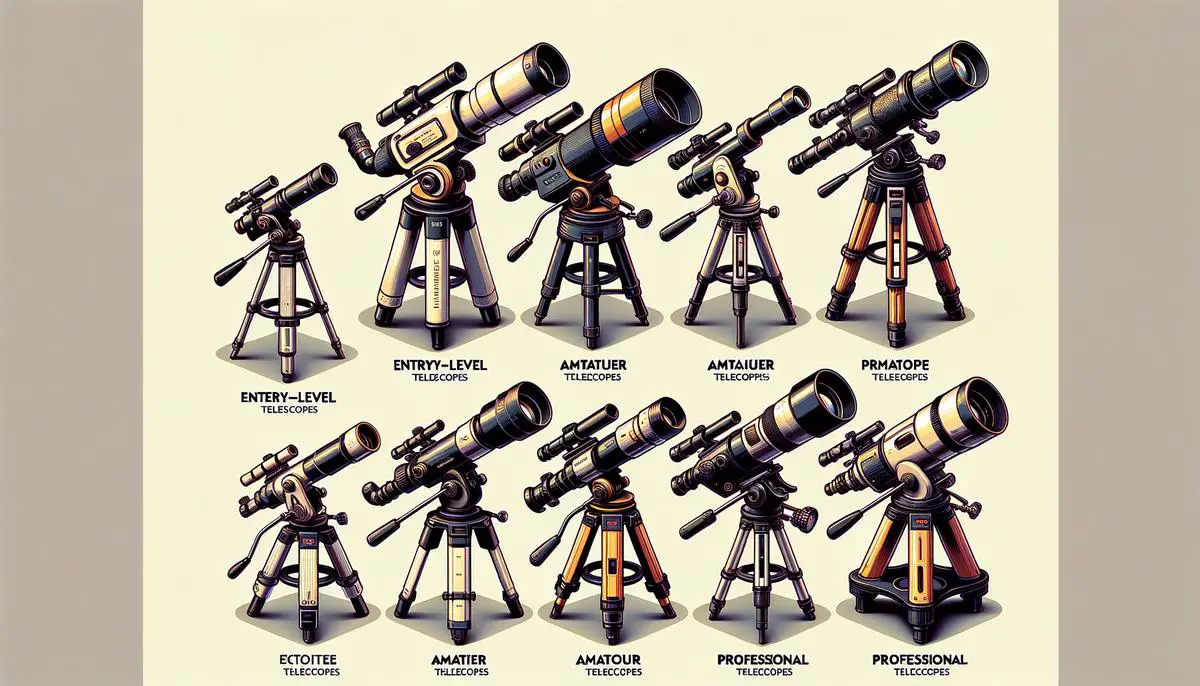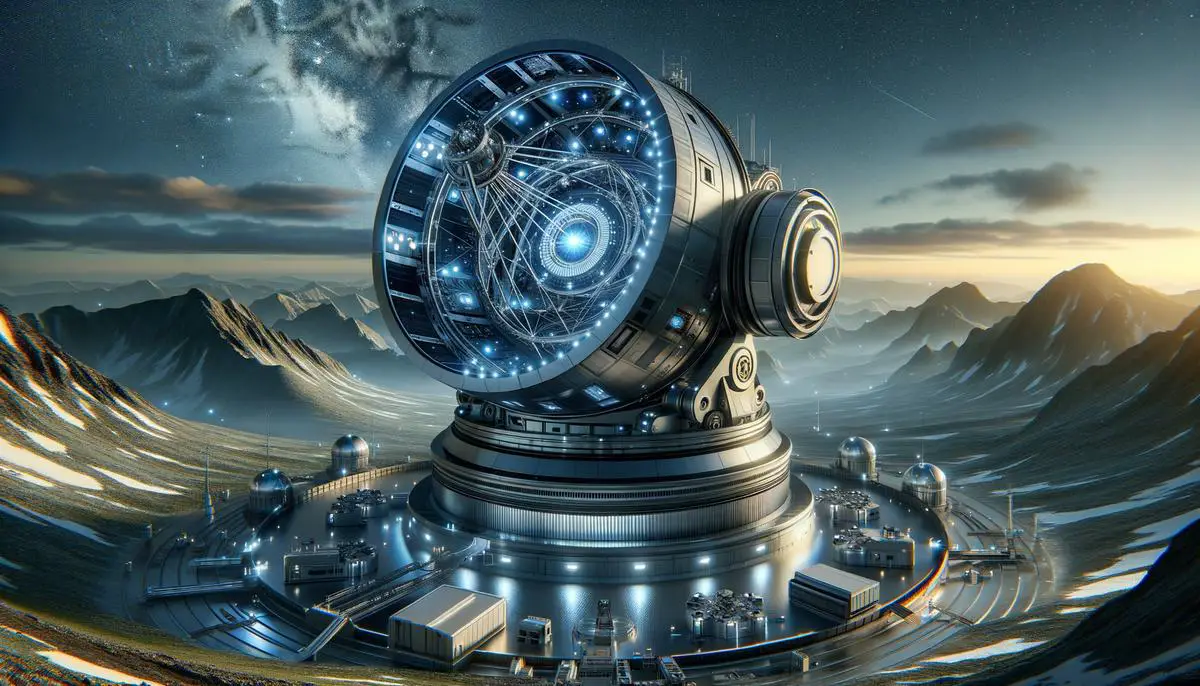GoTo mount technology represents a significant advancement for stargazing enthusiasts, offering a streamlined and efficient way to gaze at the night sky. This system, akin to a celestial GPS, simplifies the process of locating and tracking stars, planets, and galaxies, making astronomy more accessible to both novices and seasoned observers. As we examine the intricacies of GoTo mounts, software, and telescopes across various price ranges, we uncover how these tools enhance our interaction with the cosmos.
Understanding GoTo Mount Technology
GoTo mount technology is a leap forward for those who love to look up at the night sky and wonder. This system allows telescopes to quickly and accurately point toward celestial objects at the push of a button. Think of it as a GPS for the stars. A user simply selects an object to view, and the GoTo mount does the rest, using motors and a computer to guide the telescope’s lens directly to the desired point in the cosmos.
At the heart of the GoTo system lies a computerized database filled with information on thousands of stars, planets, galaxies, and more. When you choose what you want to see, the system calculates its current position in the sky. It factors in your location on Earth, the time, and the date to make this calculation. Essentially, it does all the heavy lifting that manual telescope adjustment requires but in mere seconds.
Motors embedded in the mount are another crucial component. They smoothly adjust the telescope in both vertical (altitude) and horizontal (azimuth) axes. This dual-axis movement enables the telescope to pinpoint objects with astonishing precision. The motors keep tracking the object too. As the Earth rotates, stars seem to move across the sky. The GoTo mount’s motors counteract this apparent movement, keeping your chosen star or galaxy in view without you needing to adjust the telescope manually.
For stargazing enthusiasts, this technology means more time observing and less time searching. It opens up more opportunities to explore deep-sky objects, which might be difficult to locate without detailed astronomical knowledge. For instance, finding the Andromeda Galaxy or Orion Nebula becomes as simple as selecting it from a menu. The GoTo mount handles finding their current position in the night sky.
Another advantage of GoTo mounts is their educational value. The database can offer fascinating information about each celestial object you view, enhancing the stargazing experience. It’s like having a virtual astronomy guide at your side. This feature is particularly appealing for beginners or those stargazing with young astronomers, turning each observing session into a learning opportunity.
Despite their advanced capabilities, GoTo mounts are designed with users in mind, making them accessible even to those new to astronomy. Setup is straightforward, with some models offering features like automatic alignment. This means the telescope can calibrate itself after you input a few pieces of information.
For those who enjoy astrophotography, GoTo mounts are invaluable. They provide the stability and precision required for long-exposure photography, capturing breathtaking images of distant celestial bodies. Imagine photographing the craters of the Moon, rings of Saturn, or bands of Jupiter with clear definition.
In summary, GoTo mount technology transforms stargazing into an accessible, educational, and engaging hobby. Whether you’re a seasoned astronomer or a curious novice, this technology enhances the way you explore the universe, turning each night under the stars into a new adventure.

The Role of Software in GoTo Telescopes
Shifting gears from the outer shell to the very heart of GoTo telescopes, one encounters the software that is essentially the brain of the operation. This software, invisible yet indispensable, navigates the realms of time and space with surprising ease, offering a cosmic dance at the fingertips of the astronomer.
Embedded within each GoTo telescope, this software plays the critical role of interpreter and guide. It translates complex astronomical data into precise mechanical movements. Imagine aiming to catch a glimpse of Neptune. The software analyses your request against a vast celestial library, calculates Neptune’s current position in the night sky, accounting for Earth’s rotation, and orchestrates the telescope’s movements to bring Neptune into your view.
The user interface, the human-facing side of this software, deserves its spotlight. It’s crafted not just for functionality but for engagement. Users are greeted with interfaces that may vary from simple button commands to sophisticated graphical displays. This interface is your control panel for cosmic exploration, designed with intuition in mind, it simplifies the navigation through millions of stars and galaxies, presenting the universe in a manner that’s understandable, yet leaves room for the thrill of exploration.
For instance, some telescopes come equipped with software that allows you to enter a date and time, offering a retrospective sky map. Want to know what the sky looked like on your birthday 10 years ago? This feature has you covered. It’s not just about looking at stars; it’s about connecting with the cosmos on a personal level.
Moreover, this software isn’t static. With updates, it adapts and grows, reflecting new discoveries and astronomical findings. The user thus remains at the cutting edge of celestial understanding, their telescope an ever-evolving window to the universe.
While its primary function is guiding the telescope, the software also serves an educational purpose. Hover over an object onscreen, and you might find yourself diving into a treasure trove of information—history, mythology, scientific data—turning a stargazing session into a comprehensive learning experience.
Compatibility also comes into play. Advanced GoTo telescopes offer software that connects to smartphones or tablets. This integration brings a level of flexibility and comfort to astronomy. You could be setting up your telescope in North America and sharing views of Saturn with a friend in Europe, all through the magic of software.
In summary, diving into the world of GoTo telescopes’ software unveils a manifold of intricacies that go beyond mere programmed commands. It’s about breathing life into metal and glass, transforming them into conduits for human curiosity. It ensures that every interaction with the night sky is seamless, personal, and enriched with knowledge, making it an indispensable component of modern stargazing. Every beep, click, and whirl you hear is a testament to the software’s silent yet impactful role in connecting us with the stars.

Comparing GoTo Telescopes Across Price Ranges
Entry-level GoTo telescopes, priced under $500, often pack surprising value for beginners. These telescopes usually offer a solid introductory experience to the GoTo system, allowing users to automatically track celestial objects with reasonable accuracy. However, the trade-off at this price point often includes a smaller aperture and less durable construction materials, limiting the observatory power and overall longevity of the device.
Mid-range GoTo telescopes, found in the $500 to $1000 bracket, make noticeable improvements in both optics and build quality. At this level, users can expect larger apertures, offering clearer and more detailed views of the stars, planets, and even some deep-sky objects. The mount and tripod are typically sturdier, providing more stability during observation and photography. Software features in this range may also offer more advanced capabilities, like more extensive databases and more precise tracking algorithms, enhancing the viewing experience.
High-end GoTo telescopes, which exceed the $1000 mark, are where the technology and quality leap forward significantly. Telescopes in this category often feature premium optics with larger apertures and high-quality coatings that maximize light gathering and clarity. The construction uses materials designed for durability and precision, including more sophisticated and responsive motors that can accurately track objects over long observation periods. Additional high-end features might include built-in Wi-Fi or GPS for easier setup and alignment, as well as accessories like high-quality eyepieces and filters that can significantly enhance observation.
The luxury side of GoTo telescopes can skyrocket well above $2000, targeting professional astronomers and serious amateurs. These telescopes boast the pinnacle of optical quality and technological innovation. Users can expect ultra-large apertures, potentially up to 12 inches or more, which reveal breathtaking details and deep-sky objects that are beyond the reach of lower-priced models. The mounts are engineered for supreme accuracy and can often support heavy-duty photography setups with elaborate guide scopes. Software integration at this level includes highly advanced features, such as detailed customization of tracking algorithms and integration with third-party astronomical software for comprehensive data analysis and observation planning.
Each price bracket reveals a trade-off between cost and capabilities where the primary considerations include optical quality, software sophistication, and durability. As the budget increases, so do the quality of observation and the ease with which these complex celestial objects can be tracked and studied, offering a more immersive and engaging stargazing experience.

The Impact of Aperture Size in GoTo Telescopes
Aperture size in GoTo telescopes is akin to the gateway through which the universe reveals its secrets to us. Larger apertures allow more light to enter the telescope, much like opening a window wider on a dark night to let in more moonlight. This influx of light is crucial as it determines the brightness and clarity of the celestial bodies we observe.
Think of aperture size as the pupil of an eye. In dim light, our pupils expand to let in more light, enhancing our ability to see in the dark. Similarly, a telescope with a large aperture permits a greater amount of light to reach the telescope’s eyepiece or camera, illuminating distant galaxies, nebulae, and star clusters like never before.
Fine details become the main event, not just a sideshow, when aperture steps into the ring. It’s quite straightforward: the larger the aperture, the better the resolution. Resolution, in this context, speaks to a telescope’s competence in dissecting intricate details of celestial phenomena, splitting closely-knit double stars, or unearthing the intricate crevices in a nebula’s cloud of dust and gas. This increased capacity to capture finer details births a richer and more engaging observational experience.
However, in the dance between function and form, aperture size does not dance alone. Portability plays its part. GoTo telescopes marry sophisticated technology with ease of use, offering astronomers of all levels the ability to survey the night sky with precision and ease. Yet, the larger the aperture, the bulkier the telescope. Thus, a balance must be struck. A hefty aperture size might summon the cosmos in brilliant detail but hauling a cumbersome setup can be off-putting.
This is where the crux of optimization saunters in. GoTo telescopes strive for a harmonious balance between aperture size and manageability. Without sacrificing too much on either end of the spectrum, manufacturers design these marvels to offer a sweet spot; a place where vivid clarity meets transportable convenience.
Amid this tightrope walk of size versus utility, observing conditions play their silent tune. Light pollution, a nemesis to astronomers both amateur and seasoned, compromises what small apertures can achieve under suburban skies let alone urban ones. Here, even modest magnification reveals the advantage of larger apertures which, adept at gathering light, can pierce through the veil of Earth’s luminous intrusion to whisk us away to the darker recesses of the universe.
Speaking of ventures into the cosmos, astrophotography—a joyful intersection of art and science—thrives on ample apertures. Larger apertures not only unveil the universe’s grand spectacle but also cut down exposure time, a boon for those capturing cosmic moments. Capturing photons that have journeyed across time and space becomes less of a waiting game and more about the thrill of immediate discovery.
So, while GoTo telescopes redefine our celestial engagements through advanced technology and software precision, it remains the humble aperture—at heart a simple concept—that rules as the gatekeeper to the cosmos. It is through this lens that hobbyist stargazers and hardened astronomers alike delve into observations richer and more profound than those afforded by their less endowed counterparts. The challenge lies in embracing this potential without being weighted down by it—literally and figuratively—a challenge that GoTo telescopes with careful design continue to navigate successfully.

Future Trends in GoTo Telescope Technology
Emerging trends in battery technology and power efficiency are set to revolutionize GoTo telescopes, enabling longer observation sessions without the need for frequent recharging. These advancements promise to significantly extend the time astronomers spend under the stars, facilitating uninterrupted deep-sky exploration.
The integration of artificial intelligence (AI) and machine learning into GoTo telescopes can offer personalized recommendations based on user behavior, enhancing the discovery process. For instance, the telescope might suggest observing targets similar to those you’ve shown interest in before, or it could adjust its recommendations based on the time of year and your geographical location.
Augmented reality (AR) has the potential to transform the way we interact with GoTo telescopes, overlaying information directly onto the night sky as viewed through the eyepiece. This could include data on celestial objects, constellation patterns, or even real-time identification and tracking of satellites.
Cloud connectivity in GoTo telescopes could enable users to share discoveries and observations with a global community of astronomers, fostering collaboration and learning. This networked approach could also allow for collective data analysis and crowd-sourced projects, such as tracking changes in star brightness or documenting comet paths.
Advancements in sensor technology may greatly improve the telescopes’ ability to detect faint objects, pushing the boundaries of what amateur astronomers can observe from their backyards. With better sensors, these telescopes could bring distant, dim galaxies and nebulae into clearer view, making them accessible to a wider audience.
Optical enhancements aiming to reduce chromatic aberration and improve light transmission are expected to produce sharper, more vibrant images, bringing out subtle details in celestial objects that were previously challenging to observe. These improvements not only benefit visual observation but also enhance the quality of photographs taken through the telescope, satisfying both visual astronomers and astrophotographers.
Firmware updates could introduce smarter alignment processes, simplifying setup and calibration. By implementing more intuitive alignment methods, these telescopes could become immediately usable, even for beginners, removing one of the hurdles to starting in amateur astronomy.
Noise reduction mechanisms in the motor drives of GoTo telescopes are on the horizon, aiming to create a more serene observing experience. Quieter operation would be particularly beneficial during astrophotography sessions, where even minor vibrations can impact image quality.
Ultimately, future innovations in GoTo telescope technology are poised to make astronomy more accessible, intuitive, and rewarding for everyone involved. From extending observation times to bringing distant celestial wonders into clearer view, these breakthroughs promise to open up new vistas in our exploration of the night sky.

In conclusion, GoTo mount technology fundamentally transforms our stargazing experience, making it more immediate, educational, and engaging. By bridging the gap between human curiosity and the vast expanse of the universe, this technology invites users of all levels to partake in the awe-inspiring adventure of astronomy. The essence of GoTo technology lies in its ability to bring the cosmos closer to us, turning every night under the stars into a journey filled with discovery.
![]()
